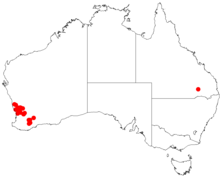Acacia shuttleworthii
Acacia shuttleworthii is a shrub of the genus Acacia and the subgenus Phyllodineae that is endemic to western Australia.
| Acacia shuttleworthii | |
|---|---|
| Scientific classification | |
| Kingdom: | Plantae |
| Clade: | Tracheophytes |
| Clade: | Angiosperms |
| Clade: | Eudicots |
| Clade: | Rosids |
| Order: | Fabales |
| Family: | Fabaceae |
| Clade: | Mimosoideae |
| Genus: | Acacia |
| Species: | A. shuttleworthii |
| Binomial name | |
| Acacia shuttleworthii | |
 | |
| Occurrence data from AVH | |
Description
The low compact shrub typically grows to a height of 0.25 to 0.5 metres (0.8 to 1.6 ft).[1] It has finely ribbed, green coloured branchlets that are quite hairy with persistent stipules that have a linear-triangular shape and are 1 to 3 mm (0.039 to 0.118 in) in length. Like most species of Acacia it has phyllodes rather than true leaves. The oblique, ovate to elliptic or circular shaped phyllodes have a length of 5 to 16 mm (0.20 to 0.63 in) and a width of 3 to 11 mm (0.12 to 0.43 in) and are also covered in hairs and sometimes have two or three imperfect nerves on each face.[2] It blooms from October to December and produces cream-white flowers.[1]
Taxonomy
The species was first formally described by the botanist Carl Meissner in 1844 as a part of Johann Georg Christian Lehmanns wotk Plantae Preissianae. It was reclassified as Racosperma shuttleworthii in 2003 by Leslie Pedley then transferred back to genus Acacia in 2006.[3]
Distribution
It is native to an area in the Wheatbelt region of Western Australia where it is found on hills and breakaways growing in lateritic soils. It has a disjunct distribution from around Dandaragan in the north to around Gnowangerup in the south[1] growing in gravelly clay and sandy soils as a part of Eucalyptus wandoo woodland communities.[2]
See also
References
- "Acacia shuttleworthii". FloraBase. Western Australian Government Department of Parks and Wildlife.
- "Acacia shuttleworthii Meisn". Wattle - Acacias of Australia. Lucid Central. Retrieved 8 September 2019.
- "Acacia shuttleworthii Meisn". Atlas of Living Australia. Global Biodiversity Information Facility. Retrieved 30 August 2020.